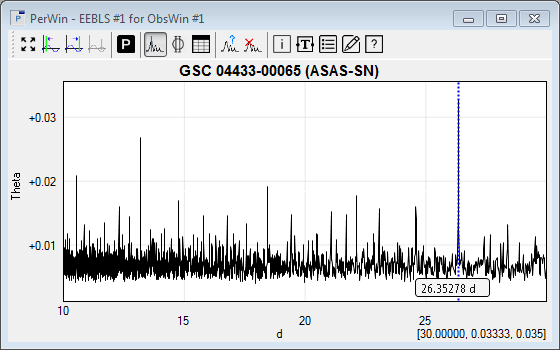- We know from Tutorial 6 that EEBLS searches for signals characterized by a periodic alternation between two discrete levels, with much less time spent at the lower level. This is exactly what eclipsing binaries do. So, let's use EEBLS to detect the orbital period of GSC 04433-00065.
- Open the aligned ObsWin GSC 04433-00065 from previous section. A visual inspection indicates that the period of this system is roughly 20 days. We will now perform a more in-depth period analysis. Click the Period Determination button in the ObsWin toolbar and select the EEBLS method. We select Days and Time and use a Range going from 10 to 30 days and 2500 Steps. In the Additional parameters section, we select 1500 bins in Nb.
Looking at various sections of the light curve, it's difficult to asses how 'wide' an eclipse of GSC 04433-00065 is. Hence, we should use Min and Max fractional transit length values that cover a rather broad range. We therefore will search for transits with a fractional length between 0.01 and 0.1 days, which we resp. enter in the Min fractional transit length and Max fractional transit length boxes. Note that a smaller range will result in faster calculations.
Click Apply to start the EEBLS calculation. The EEBLS algorithm aims to find the best model with estimators for the orbital period, eclipse depth and duration, as well as the epoch of mid transit and the phase of ingress and egress.
- This creates a Period Window (PerWin) with the EEBLS spectrum. Using the PerWin Info box, we note that the dominant period is 26.35278 +/- 0.01852 days, which corresponds quite well with the value of 26.35150 days, mentioned by Sebastian Otero who used more observations for his analysis work.

- Click the PhaseWin at Frequency Cursor value button
 in the PerWin toolbar to display a Phase Window showing the observations folded over the above period. Switch to Single Phase View and in the PhaseWin context menu select Show/hide EEBLS fit. in the PerWin toolbar to display a Phase Window showing the observations folded over the above period. Switch to Single Phase View and in the PhaseWin context menu select Show/hide EEBLS fit.

- The EEBLS fit marks the primary eclipse in the GSC 04433-00065 light curve. It is centered near Phase 0.24. Clearly visible is the secondary eclipse near Phase 0.43, indicating this is a very eccentric EA variable star.
|